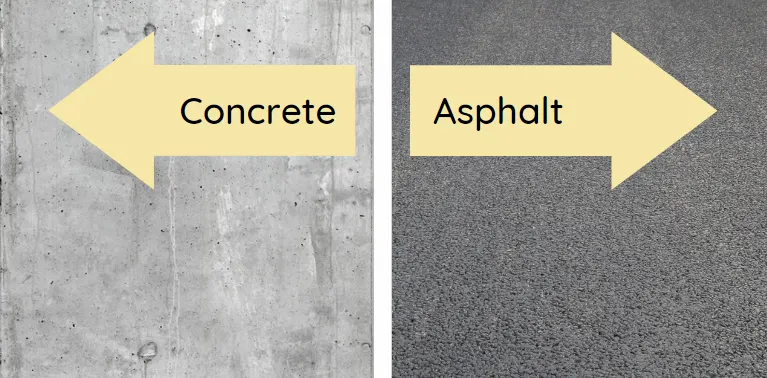For commercial parking lots, there are two common paving materials to consider: concrete and asphalt.
Both concrete and asphalt make for durable and attractive parking surfaces but there’s more to choosing between them than just looks. While both are blends of sand and crushed stone called aggregate, they differ in many areas including durability, maintenance techniques, and specific use cases.
Let’s take a look at the pros and cons of both popular, durable paving materials to help you determine which is the best for your commercial parking lot.
What is Concrete?

Concrete is composed of a blend of gravel, sand, cement and water. It is best utilized for conditions where heavy truck traffic will be expected. It is also most commonly used where there will be extended point loadings from truck dollies, trash compactors, and in areas where oil or hazardous materials are stored to assist in spill or leak mitigation.
One specific-use paving material called Pervious concrete allows water to percolate through its surface acting as a surface drain. This is most commonly used for low lying areas that would hold water otherwise and is incorporated in a number of uses including pedestrian walkways, driveways, and portions of parking lots.
What is Asphalt?

Asphalt is a blend of a range of aggregate sizes and liquid binder – the glue – mixed and manufactured in a plant. The blend is approximately 95% aggregate and 5% liquid binder. The exact amount of each is determined by the intended use of the surface, anticipated loadings, and its design criteria.
Durability/Longevity
Concrete and asphalt rank high on the durability scale but both have their limitations.
Concrete can generally last up to 30 years and beyond if constructed properly. It’s strong in compressive strength so it’s resistant to surface loads and is a rigid pavement, meaning it does not deflect under loading. Since it does not utilize any oil based bituminous components, it does not need to be sealcoated to maintain its integrity and is good to go with very little maintenance required.
Asphalt doesn’t perform as well under heavy loads or in areas where water is ponded and can lead to certain areas cracking, the formation of potholes, and fatigue cracking indicating a permanent failure.
While asphalt parking surfaces can last up to 18 years, it’s important to note that this parking surface will require more general maintenance and repair overtime than concrete.
Appearance

Depending on the aesthetic you’re going for, you will want to consider the color of the surface. Asphalt surfaces start out black and oxidize to gray over time, while concrete surfaces are gray to white naturally but can be poured with integral color for aesthetics.
Concrete tends to have a smoother, more polished appearance and, because of its light color, reflects sunlight instead of absorbing it. This is an important consideration for areas where the urban heat island effect is a concern and for municipalities which require high albedo surfaces.
Maintenance
Both concrete and asphalt surfaces require general and routine maintenance. Concrete surfaces are inflexible and can crack over time. This is usually due to improper joint spacing. The best way to maintain failed areas of concrete is to cut and replace them full depth and to seal cracks to prevent more costly repairs.
The majority of asphalt failures come from a combination of poor drainage and fatigue cracking from heavy traffic loads, which can lead to potholes and sinkholes when left untreated. Surface failures such as raveling, loose aggregate on the surface are the result of oxidation from sun removing the top layer of liquid binder. To prevent this, routine sealcoating should be implemented.
Sealcoating provides a protective layer on top of the pavement surface that does not allow it to oxidize and thus keeps the top layer of rock secure in place.
We recommend you consider sealcoating as part of an ongoing and budgeted maintenance program instead of as a remedial process once damage has been discovered.
Cost
To address the question of cost of asphalt versus asphalt, concrete is more costly on the front end but will last longer with less required maintenance and asphalt is less costly on the front end but comes with a higher lifetime maintenance cost. This is why we look at intended use as one of our primary deciding factors in which material to use.
Contact us today to get a FREE estimate for your commercial parking surface!
Concrete Vs Asphalt Comparison Chart
Let’s break it down!
| Asphalt Parking Lot | Concrete Parking Lot | |
| Durability | Durable in standard traffic and parking lot applications, susceptible to failure under repeated loadings | Best for high traffic or heavy loading conditions, in areas of heavy water concentration, and areas receiving point loads |
| Longevity | Up to 18 years | Up to 30 years |
| Appearance | – Black/Grey and semi-smooth – Can see aggregate at the surface – Aesthetic and longevity can be modified by sealcoating | – Typically gray in color, smooth with brush finish – Cannot see aggregate at the surface – Aesthetic can be modified by dying and/or stamping |
| Maintenance | Requires resealing every 2-3 years | Sealing isn’t required but doing so can prolong life |
| Cost | Low front end, higher maintenance costs | Higher front end, lower lifetime maintenance costs |
| Other Benefits | Sustainability and perpetuity | Reflectivity, high albedo surface |
Schedule a FREE Parking Lot Paving Estimate
As Florida’s top paving company, our team is experienced in asphalt paving, sealcoating, concrete work and striping for commercial properties, including condos, HOAs, shopping malls and more.
Get a FREE quote for your commercial paving job today.





